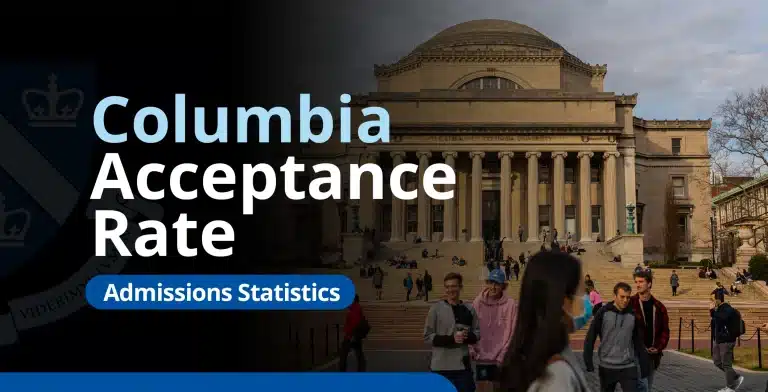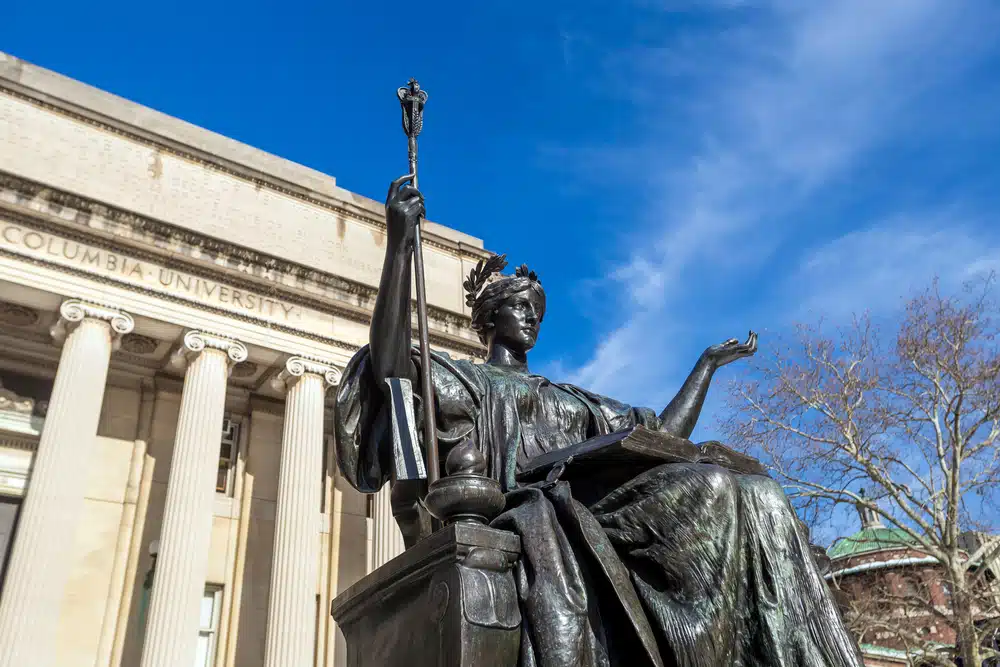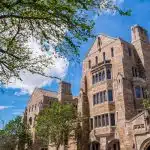Every year, thousands of students dream of getting into Columbia University. The reality, though, is that the odds are not exactly in your favor. The Columbia acceptance rate for the Class of 2029 is only 4.3%, making it one of the hardest schools to gain admission to.
With such a low acceptance rate, you’re going to need more than just stellar grades to secure a spot. Knowing what the acceptance rates look like can help set realistic expectations and guide you in crafting a stronger, more targeted application. Whether you’re aiming for Regular Decision or going all in with Early Decision, getting familiar with these details can sharpen your strategy and, hopefully, up your chances of receiving that acceptance letter.
- What Is Columbia’s Acceptance Rate?
- Columbia Acceptance Rate Trends
- Columbia Regular Decision Acceptance Rate
- Columbia Early Decision Acceptance Rate
- How to Get Accepted into Columbia
- Columbia Transfer Acceptance Rate
- Columbia Waitlist Acceptance Rate
- Frequently Asked Questions
- Takeaways
What Is Columbia’s Acceptance Rate?
Columbia University is known for its cutthroat admissions process, and the numbers for the Class of 2029 just drive that point home. The Columbia acceptance rate for this class was a mere 4.3%: out of a massive 59,616 applicants, only 2,557 were let in. Columbia’s latest acceptance rate is slightly higher than that of the Class of 2028, which was 3.85%.
Let’s break it down a bit. Columbia’s admissions are split between Regular Decision (RD) and Early Decision (ED) rounds:
| Application Type | Total Applications | Accepted | Acceptance Rate |
| Regular Decision | 53,744 | TBA | TBA |
| Early Decision | 5,872 | TBA | TBA |
| Overall | 59,616 | 2,557 | 4.3% |
Columbia hasn’t released all the Class of 2029 statistics yet, but typically, applying ED gives you slightly better odds. For the Class of 2028, the ED acceptance rate was approximately 11.9%, compared to just 2.95% for RD.
So, what’s the takeaway? Applying early might give you a slight leg up, but with such low acceptance rates all around, there’s no guaranteed shortcut. If you’re aiming for Columbia, you’ve got to pull out all the stops. Your application needs to shine in every category—academics, extracurriculars, essays, and recommendation letters—if you want to stand a chance.
Columbia yield rate
While the acceptance rate tells you how tough it is to get into Columbia, the yield rate shows just how badly students want in once they’ve got that acceptance letter. For the Class of 2028, the yield rate was a solid 65%. Out of the 2,319 students who were accepted, 1,499 decided to enroll.
What does that mean for you? It shows that Columbia is still a top pick for high-achieving students, even when they’ve got other Ivy League offers on the table. That strong yield rate reflects the school’s unbeatable mix of academic intensity, prime New York City location, and vibrant campus culture. So, not only are you competing against a ton of applicants, but you’re also up against a group of students who are eager to secure their spot once they get in.
Columbia Acceptance Rate Trends
Over the past decade, the Columbia acceptance rate has been on a steady decline, even as the number of applications keeps shooting up. The competition is fiercer than ever, and it’s not slowing down. Let’s zoom in on the numbers:
| Columbia Class | Total Applications | Overall Acceptance Rate |
| 2029 | 59,616 | 4.3% |
| 2028 | 60,248 | 3.85% |
| 2027 | 57,129 | 3.85% |
| 2026 | 60,377 | 3.7% |
| 2025 | 60,551 | 3.7% |
| 2024 | 40,084 | 6.2% |
| 2023 | 42,569 | 5.1% |
| 2022 | 40,203 | 5.5% |
| 2021 | 37,389 | 5.8% |
| 2020 | 36,292 | 6% |
Back in the day—say, for the Class of 2020—Columbia’s acceptance rate was around 6%. Fast forward to the Class of 2029, and it’s down to 4.3%. That drop really started picking up speed with the Class of 2024, thanks in large part to the test-optional policy many schools adopted during the COVID-19 pandemic. With no SAT or ACT scores required, a flood of students took their shot, driving up applications and, naturally, pushing acceptance rates down.
The applicant pool isn’t just growing, mind you. It’s getting stronger. The students applying now are more qualified than ever.
Columbia’s acceptance rate vs other Ivy League schools
When you stack the Columbia acceptance rate against other Ivies, it’s definitely among the toughest. Since not all Ivies have released their Class of 2029 statistics yet, let’s just compare their Class of 2028 acceptance rates:
| Ivy League School | Acceptance Rate (Class of 2028) |
| Harvard University | 3.6% |
| Yale University | 3.7% |
| Columbia University | 3.85% |
| Princeton University | 4.6% |
| Brown University | 5.2% |
| Dartmouth College | 5.3% |
| University of Pennsylvania | 5.4% |
| Cornell University | 8.4% |
Harvard leads the pack with a razor-thin 3.6% acceptance rate, followed closely by Yale at 3.7%. Columbia’s 3.85% is slightly more forgiving, but still tougher than Princeton’s 4.6% and miles ahead of Cornell, which sits at 8.4%. Despite these tiny differences, all of these schools are insanely hard to get into.
Columbia Regular Decision Acceptance Rate
Columbia hasn’t released its Regular Decision (RD) acceptance rate for the Class of 2029 yet.
For the Class of 2028, the Columbia acceptance rate for RD applicants hit a new low—just 2.95%. Out of about 54,239 applications, fewer than 1,600 students made the cut. That’s even lower than the overall acceptance rate of 3.85%.
Looking back over the past decade, you’ll see a steady decline in Columbia’s RD acceptance rates:
| Columbia Class | Total Regular Decision Applications | Regular Decision Acceptance Rate |
| 2029 | 53,744 | TBA |
| 2028 | 54,239 | 2.95% |
| 2027 | 51,391 | 3.1% |
| 2026 | 54,072 | 3% |
| 2025 | 54,116 | 2.9% |
| 2024 | 35,766 | 5.1% |
| 2023 | 38,108 | 4% |
| 2022 | 36,118 | 4.3% |
| 2021 | 33,303 | 4.6% |
| 2020 | 32,772 | 4.7% |
The competitiveness of Columbia’s RD route was especially noticeable starting with the Class of 2025, when the RD acceptance rate dropped to 2.9%—right around the time the test-optional policy kicked in due to COVID-19. That change drove up applications as more students thought they had a shot without standardized test scores. As demand to snag a spot at Columbia keeps climbing, the acceptance rate keeps shrinking.
Remember, though, that these numbers are estimates. Columbia doesn’t officially release details on RD admissions, so these figures are calculated by subtracting ED admissions from the total. We’ve pieced together these estimates based on what Columbia has publicly shared.
Columbia Regular Decision deadline and notification date
If you’re eyeing Columbia’s RD round, circle January 1 on your calendar—that’s the deadline. And expect to hear back in late March when they release decisions. If you’re one of the lucky ones to get that acceptance letter, you’ll need to decide by May 1 whether you’re committing.
Timing is everything here, especially if you’re also applying to other highly selective schools. Start prepping your application materials well before the deadline because the RD pool is intensely competitive. Having a polished application ready by January 1 could be the edge you need to stand out among the thousands of hopefuls aiming to join Columbia’s next freshman class.
Columbia Early Decision Acceptance Rate
Like their Regular Decision (RD) rate, Columbia hasn’t released its Early Decision (ED) acceptance rate for the Class of 2029 yet.
For the Class of 2028, the Columbia ED acceptance rate stood at 11.9%. That’s definitely better than the RD rate of 2.95% and the overall acceptance rate of 3.85%.
Looking at the trend over the past decade, there’s a clear pattern:
| Columbia Class | Total Early Decision Applications | Early Decision Acceptance Rate |
| 2029 | 5,872 | TBA |
| 2028 | 6,009 | 11.9% |
| 2027 | 5,738 | 11.3% |
| 2026 | 6,305 | 10.3% |
| 2025 | 6,435 | 10.1% |
| 2024 | 4,318 | 15.1% |
| 2023 | 4,461 | 14.6% |
| 2022 | 4,085 | 15.9% |
| 2021 | 4,086 | 15.9% |
| 2020 | 3,520 | 17.6% |
The Columbia ED acceptance rate has been shrinking as more students try to leverage that slight advantage of applying early. For the Class of 2020, the ED acceptance rate was around 17.6%. But fast forward to the Class of 2028, and it’s dropped to 11.9%. That’s because the number of Early Decision applications has steadily risen, making the competition even tougher.
Now, what exactly is ED? It’s a binding commitment—meaning if Columbia says yes, you’re in, and you’ve got to drop any other applications you’ve sent out. This can work in your favor because admissions knows you’re committed, which means they’re more likely to admit you if they’re on the fence.
But don’t rush into it. That binding agreement also means you can’t shop around for better financial aid offers, so only go this route if you’re absolutely sure Columbia’s your top choice, both academically and financially.
Columbia Early Decision deadline and notification date
If you’re ready to commit to Columbia through ED, the deadline to apply is November 1. You’ll hear back by mid-December. If you get in, you’ll need to confirm by mid-January and withdraw any other college applications you’ve sent out. So, be sure you’re fully prepared to take the plunge if you choose this path.
How to Get Accepted into Columbia
Applying to Columbia University takes serious prep and a solid strategy. Columbia accepts applications through the Common App, Coalition App, or QuestBridge. You can review Columbia’s first-year application requirements to ensure your application meets all the necessary criteria. Whichever platform you choose, make sure your application highlights what makes you shine and aligns with what Columbia is really looking for.
Let’s break down the essentials to help you boost your odds against that tough Columbia acceptance rate:
Target GPA
If you’re serious about getting into Columbia, you’ll need an impressive academic track record. Most admitted students have an average GPA around 3.9 on a 4.0 scale. In other words, you should aim for nearly straight A’s, especially in challenging AP or IB courses if your school offers them.
But here’s the thing—it’s not just about stacking up perfect grades. Columbia wants to see that you pushed yourself in tough classes. If your GPA isn’t quite there, showing an upward trend or excelling in more rigorous courses can still keep you in the game.
Target test scores
Columbia is currently test-optional, which means you don’t have to submit SAT or ACT scores. But if you do, make sure they’re strong. According to Columbia’s Common Data Set for 2023-2024, the middle 50% of admitted students scored between 1500-1560 on the SAT or 34-35 on the ACT. If your scores fall in the upper end of that range, it can definitely boost your chances.
That said, if your test scores aren’t as high but you’ve got stellar grades, compelling essays, and standout extracurriculars, you’re not out of the running. Submitting strong test scores can give your application a bit more weight, especially if other areas could use a little extra push. Weigh the decision carefully based on where your scores land in Columbia’s range.
Other requirements
Columbia is looking for passionate, driven individuals who’ve shown leadership and commitment in their extracurriculars. Admissions officers are on the lookout for depth over breadth, so aim for long-term involvement, especially in areas that resonate with Columbia’s values, like civic engagement or research.
Now, about those essays. Beyond the Common App or Coalition App personal statement, you’ll also need to tackle five Columbia-specific supplemental essays. This is where you can really show them who you are. Use these essays to highlight not just what you’ve done, but also what drives you and how you fit into Columbia’s mission.
Recommendation letters are also vital. You’ll need three: two from teachers and one from your school counselor. If you’re applying to Columbia Engineering, make sure at least one comes from a math or science teacher. These letters should highlight your character, intellectual curiosity, and how you contribute to your school community. Pick teachers who know you well and can speak to your strengths beyond the classroom.
For more insights on crafting a standout application, check out our detailed guide on getting into Columbia.
Columbia Transfer Acceptance Rate
According to its Common Data Set for 2023-2024 (Class of 2027), Columbia received 3,254 transfer applications, but only 329 of those hopefuls made it through. That leaves you staring down a transfer acceptance rate of just 10.1%. And of those who were admitted, only 276 ended up enrolling.
So, what does that tell you? Freshman or transferee, it’s tough to get in, plain and simple. Columbia’s transfer admissions process is particularly cutthroat, partly because they’ve got limited spots to fill.
If you’re thinking about transferring, you’ll need to show up with a stellar academic record from your current school, a compelling reason why Columbia is the right fit for you, and application materials that really shine. continuing your education can improve your chances of acceptance.
Columbia Waitlist Acceptance Rate
Being waitlisted at Columbia means you’re neither accepted nor rejected. And to make it worse, Columbia doesn’t share official numbers on its waitlist acceptance rate, so you’re left guessing.
Based on what we know from other Ivy League schools, though, Columbia likely puts around 1,000 students on its waitlist each year. Of those, about 80% usually opt to stay on the list, hoping for a spot to open up.
There’s no consistency in how many actually get in from the waitlist. Some years, Columbia might accept over 100 waitlisted students; other years, it might accept none at all. It all depends on how many admitted students decide to enroll. If Columbia’s yield rate is high, the chances of waitlisted students getting in drop significantly.
So, what does it mean if you’re waitlisted? Basically, Columbia liked your application enough to keep you in the running, but they ran out of slots. It’s a “maybe,” not a “no,” which means there’s still a sliver of hope—just don’t bank on it. Your chances really hinge on whether enough admitted students decline their offers.
If you find yourself on Columbia’s waitlist, here’s how to play it smart. First, consider sending a letter of continued interest (LOCI). Columbia appreciates students who show genuine enthusiasm. A concise, thoughtful LOCI can remind them why you’re a great fit and update them on any new accomplishments.
Speaking of updates, if you’ve won an award or pulled up your grades since you applied, let them know—it could give you a bit of an edge.
But while it’s okay to stay hopeful, you’ve also got to be practical. Make sure you’re set with another college where you’ve already been accepted, because getting off the waitlist at a place like Columbia is tough. Take proactive steps, keep your options open, and remember—whether you get in or not, you’ve still got great choices ahead of you.
Frequently Asked Questions
1. What is Columbia’s overall acceptance rate for the Class of 2029?
For the Class of 2029, Columbia accepted 2,557 students out of 59,616 applicants. That means the overall Columbia acceptance rate came in at just 4.3%.
2. What is Columbia’s Early Decision acceptance rate?
If you went the Early Decision route for the Class of 2028, the odds were a bit better. Columbia received 6,009 ED applications and admitted 721 students, giving an acceptance rate of roughly 11.9%.
3. What is Columbia’s Regular Decision acceptance rate?
Columbia doesn’t officially share its Regular Decision acceptance rate. But estimates suggest that, for the Class of 2028, it was around 2.95%. So, it’s even tougher in the regular round.
4. What is Columbia’s transfer acceptance rate?
For the Class of 2027, the transfer acceptance rate was about 10.1%. Out of 3,254 transfer applications, only 329 got admitted.
5. What is Columbia’s waitlist acceptance rate?
Columbia doesn’t release its waitlist stats. Like many other Ivies, how many they pull off the waitlist varies year to year based on how many admitted students actually enroll. Some years, they might take a decent chunk, while in other years, they admit none at all.
Takeaways
The Columbia acceptance rate is one of the toughest out there, so if you’re aiming for a spot, you’ll need a seriously solid game plan. Here’s what you need to know:
- Columbia’s latest (Class of 2029) acceptance rate is a mere 4.3%.
- Columbia is right up there among the most competitive Ivy League schools. Its acceptance rate is more selective than Princeton’s but just a bit less so than Harvard’s and Yale’s.
- If Columbia’s your dream school, applying Early Decision could give you a bit of a boost. The acceptance rate for ED is around 11.9%, while for Regular Decision, it plummets to just 2.95%. It’s a big difference, but only go this route if you’re sure you’re ready to commit.
- To be a strong contender, aim for a GPA close to 3.9 and shoot for a 1560 on the SAT and 35 on the ACT. Your essays, extracurriculars, and recommendations need to be top-notch too if you want to stand out.
- Given the incredibly low Columbia acceptance rates, reaching out to a college admissions consultant could give you a strategic advantage in crafting a compelling application.

Eric Eng
About the author
Eric Eng, the Founder and CEO of AdmissionSight, graduated with a BA from Princeton University and has one of the highest track records in the industry of placing students into Ivy League schools and top 10 universities. He has been featured on the US News & World Report for his insights on college admissions.


















